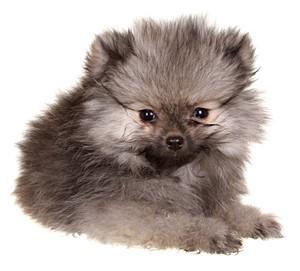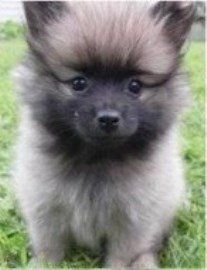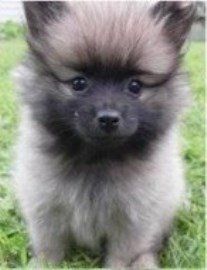Wolf Sable
PetPom

The
Pomeranian
Information
Center
Wolf Sable Pomeranians

A rare wolf sable colored Pom puppy. With lots of sabling, the Pom can appear gray. With less, a Pom can appear cream sable.
About the Wolf Sable Color
There are so many elements to love about this toy breed dog, and one of them is certainly the colors.
The Pom is one of the few purebreds that can be found in almost endless solids, parti combinations, and even tri-color coats, which are two colors and a marking.
With base coats, the element that the inner layer is able to be a different hue than the outer layer... And the possibility of markings (either mask, points, or both), it never ceases to amaze us how each Pom is so individual in regard to appearance.
Some people have a fondness for solids such a pure snow white and others are interested in more complex patterns such as brindling (which is a striping pattern) and sabling (which refers to dark tipped hairs).
With this breed you'll find common colors, such as classic orange and once in a while you'll see rare coats such as red. However, one of the most intriguing and hard to find colors is the wolf sable Pomeranian. It is also the one that confuses people the most.
This particular color has actually caused some controversy and ahead we will discuss what qualifies a Pom to be a wolf sable and why there has been some confusion in the past.
About Wolf Sable
About the Wolf Sable Color
There are so many elements to love about this toy breed dog... And one of them is certainly the colors!
The Pom is one of the few purebreds that can be found in almost endless solid, parti combinations and even tri-color coats, which is two colors and a marking.
With base coats, the element of the inner layer able to be a different hue than the outer layer... And the possibility of markings (either mask, points or both), it never ceases to amaze us how each Pom is so individual in regard to appearance.
Some people have a fondness for solids such a pure snow white and others are interested in more complex patterns such as brindling (which is a striping pattern) and sabling (which refers to dark tipped hairs).

A rare wolf sable colored Pom puppy. With lots of sabling, the Pom can appear gray. With less, a Pom can appear cream sable.
With most types of sable Poms, there are two parts to the term: the base color and then the 'sable'. For example, cream sable, orange sable and red sable. For each of those coats, cream, orange or red will be the base color.
Then, the sable will be dark tipped hairs. These may cover the entire coat or just some sections. They may be light (just a dusting) or heavy (it will be difficult to see the base color under it). This is important to remember, because with wolf sable Poms, this rule of term = base color + sable does not hold true.
With wolf sables, the term 'wolf' does not
refer to the Pom's base coat. While many will assume that wolf refers to a gray color, it does not in this case. Wolf refers to a very rare gene and we will get into that more in a bit. The sable part of the wolf sable term does, however, refer to dark tipped hairs.
So, what color is a wolf sable Pom? In most cases, the Pom will have a cream coat. If the sabling is light, you will clearly see that color. However, if the sabling is very heavy and it covers just about the entire coat, a wolf sable Pomeranian can appear to be a gray Pom. Do please note that gray is not an accepted coat color per the AKC.
This brings us to the question of, what does a wolf sable Pomeranian look like, if we are saying that he is a cream coat with sable? Well, he will appear to be just that and the only true way of knowing if he is a cream sable or a real wolf sable is via DNA testing (more ahead).
And this is where so much debate comes in. There are breeders
who look at a Pom, decide that he is wolf sable and not only register him as so (the AKC allows a breeder to check off any color that they desire) but also sell the puppy as a wolf sable. Far too many cream and light orange sables are being classified as wolf when they are not. And this really should not be happening.
It is impossible to know, just by looking, that a Pom is wolf sable. This said, breeders who have paired wolf sables together will have a good idea if the resulting litter carries the gene, but again, only DNA testing can confirm this.
In regard to skin pigmentation, wolf sable Pomeranians have black pigmentation; eye rims, nose, lips and paw pads are black.
Sabling
One element that comes into play, and the one that causes so much misunderstanding with many owners and even breeders, is the degree of sabling that is present on the dog.
Sable can range from appearing on the coat very sparingly to super heavy and covering the dog from head to tail.
And, if a Pom has sable on just about the entire coat, he is often mislabeled as a wolf sable.
True wolf sables, just like other sables, will have varying degrees of those dark tipped hairs.
It may be just on the back, on several areas or all over.
One element that comes into play, and the one that causes so much misunderstanding with many owners and even breeders, is the degree of sabling that is present on the dog.
Sable can range from appearing on the coat very sparingly to super heavy and covering the dog from head to tail. And, if a Pom has sable on just about the entire coat, he is often mislabeled as a wolf sable.
True wolf sables, just like other sables, will have varying degrees of those dark tipped hairs. It may be just on the back, on several areas or all over.
Changes with Sables
In many cases, sabling fades off as a Pomeranian matures. It may completely grow out or simply appear to a lesser degree. This happens during the phase of the
puppy uglies, when the puppy coat falls out and the adult coat grows in. This said, there are some instances of sabling coming in heavier as the pup matures, which is always a nice treat.
Since changes can be quite drastic, a true wolf sable Pom can start off with very little sabling and grow into it or
he can be covered with those dark tipped hairs as a pup but mature into an adult with very little to none.
Identifying a TrueWolf Sable Pomeranian
Identifying a True Wolf Sable Pomeranian
Far too many Pomeranians are mislabeled due to the classification of wolf sable being given just by visual confirmation and not actual confirmation.
With this particular color, unless you are only breeding wolf sables, you simply will not know unless you obtain color gene testing.
Only a DNA coat color test that looks to the Auguti locus marker place will show if there is ay (sable) or aw (the true wolf pattern gene).
The aw color gene is present in today's wolves (hence the name), coyotes, 18 different dog breeds and even some rabbits and rodents.
It is interesting to note that when the wolf sable (aw) gene is present in other breeds, it is referred to differently.
For example, with the Dachshund it is called 'wild boar' and with Shar Peis it is referred to as ‘patterned sable’.
Far too many Pomeranians are mislabeled due to the classification of wolf sable being given just by visual confirmation and not actual confirmation.
With this particular color, unless you are only breeding wolf sables, you simply will not know unless you obtain color gene testing.
Only a DNA coat color test that looks to the Auguti locus marker place will show if there is ay (sable) or aw (the true wolf pattern gene).
The aw color gene is present in today's wolves (hence the name), coyotes, 18 different dog breeds and even some rabbits and rodents.
It is interesting to note that when the wolf sable (aw) gene is present in other breeds, it is referred to differently. For example, with the Dachshund it is called 'wild boar' and with Shar Peis it is referred to as ‘patterned sable’.


Gizmo, a 3 month old Wolf Sable Pom Puppy.
Photo courtesy of owners: Jason & Candice
While both sire and dam do not need to be wolf sable to produce a wolf sable, one of the does and needs to be paired with a non-sable dog, since sable (ay) is dominant to wolf sable (aw).
Wolf Shaded Sable?
There have been some wolf sable champions and with the first two, there was some debate in regard to the vernacular and actual classification.
In the year 1892, a champion was registered as light sable, black shaded saddle, but was referred to as wolf shaded sable. The 2nd champion to be a wolf sable Pomeranian was actually registered as a fawn and black.
This is due mostly from certain descriptions being eliminated from the breed standard over the course of time and also from the above mentioned coat changes as the dog matures.
Join the PetPom Family:
This allows you to:
- Know when new pages of information is added to the site
- Be able to submit photos of your Pom to be added to the site
- Receive a free helpful & interesting Welcome Booklet
You May Also Like:
Sable Pomeranians
- From cream sable to red sable, this amazing coloring can really add depth and dimension.
Red Pomeranians
- A very rare, but beautiful color that is often confused with orange.
Pomeranian Care Tips
- The top 10 most important aspects, for optimal care.
If you email photos to us, you agree that PetPom is given free copyright to use at our discretion. We will always credit the photo to the name of the Pom's owner(s) if it is supplied.
Email: Contact@PetPom.com
All text, images and artwork protected by US and International copyright laws. All rights reserved. Copyright PetPom.com
We are a participant in the Amazon Services LLC Associates Program, an affiliate advertising program designed to provide a means for us to earn fees by linking to Amazon.com and affiliated sites.

